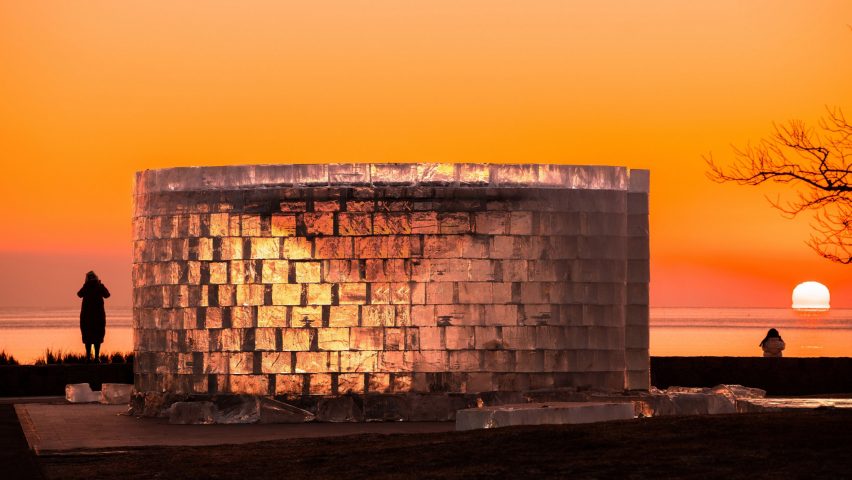Architects from the Beijing Institute of Architectural Design used a cable membrane structure and bricks of river ice to create this installation in Qinhuangdao, China, which has been shortlisted for a 2023 Dezeen Award.
A team from BIAD, led by architects Xiyan Yang, Guanjia Li and Chenzhi Yan, designed and built the Falling Hours pavilion to offer visitors a ceremonial way of marking the turn of the year.
During 2022's New Year's Eve celebrations, passersby were invited to collect sand from the beach in the coastal community of Aranya, where the installation was constructed.
This sand was poured through a hole on top of the structure, accumulating in its conical membrane roof, which effectively functioned as a huge hourglass.
At midnight, participants pulled on a ribbon to open this funnel, prompting the sand to rain onto the floor, while visitors wrote their wishes for the new year on the hourglass membrane.
The project drew on a similar roofing system to the one that BIAD helped to engineer for Foster + Partners' Lusail Stadium in Qatar.
But in this case, it consisted of a circular steel structure with a diameter of six metres and a height of three metres, supported by a tensioned cable and membrane roof designed to bear the weight of two tonnes of sand.
The cable membrane structure resembled a conical hourglass, with its forces anchored in a ring beam around the perimeter and a pressurised spar at the centre.
"The centre of the hourglass is a pressurised gusset that holds up the roof and at the same time holds up the membrane at the lower end of the spokes," said the project team.
The lower part of the membrane consisted of a semi-transparent PTFE mesh laminate, while the roof covering the upper part of the spokes was made using an ETFE plastic that allowed light to enter the interior.
Expert ice sculptors from the Harbin Ice Festival in Heilongjiang province created an outer wall around the steel framework using river ice that was clear enough to be partially see-through.
The installation's timing coincided with Qinhuangdao's coldest season and the ice wall was designed to last for around a month before gradually melting in the warming sun.
Sand from the beach was used to fill the hourglass and was returned to the beach as part of the ceremony. BIAD says the steel structure was recycled and the membrane was used as an exhibit to preserve the memory of this one-off event.
Falling Hours has been shortlisted in the installation design category of this year's Dezeen Awards alongside the French pavilion at the Venice Architecture Biennale and a showcase of repaired objects at London's V&A.
All photographs are courtesy of BIAD.

